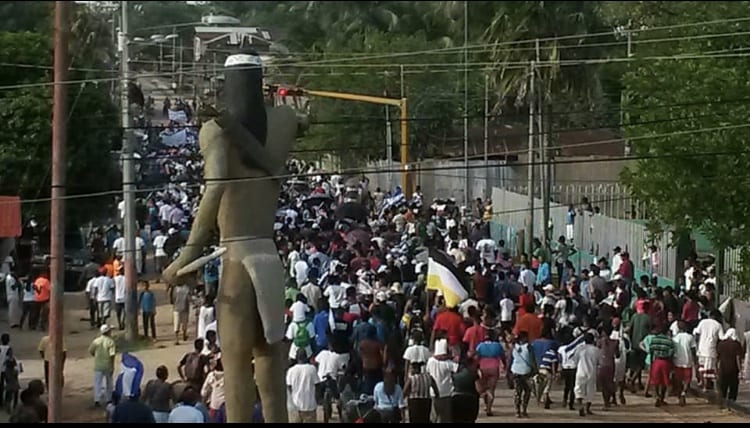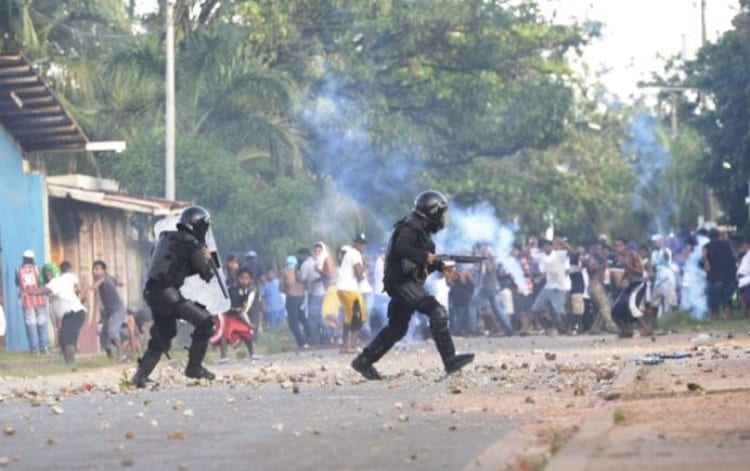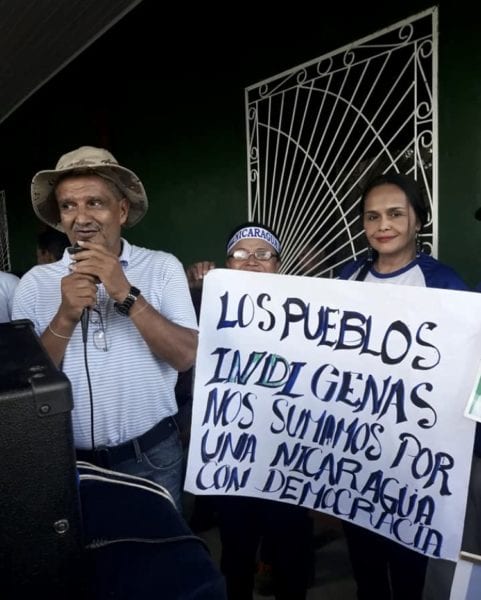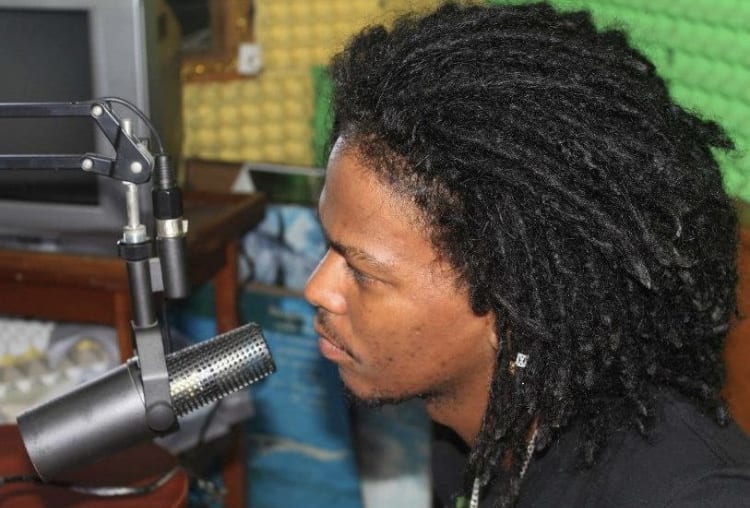Civic Rebellion Gains Momentum on Nicaraguan Caribbean Coast
By Laura Hobson Herlihy

HAVANA TIMES – In the five months since the civic revolution began in Nicaragua, Daniel Ortega’s pro-government forces have massacred over 330 opposition protestors, injured over 2,000 and taken several hundred prisoners, many whom have been tortured and sexually abused.
After the Ortega-Murillo regime passed a terrorism law that allowed for the prosecution of peaceful protestors, masked gangs of armed paramilitaries began going house to house, hunting down protestors who were then arrested or simply taken away with no further information. Thousands of Nicaraguans have fled to Costa Rica.
These events stunned the country and the international community. Ortega’s abuses have been widely condemned by international human rights organizations including the OAS and the UN High Commissioner for Human Rights. One place where they viewed the government’s new downward spiral as “more of the same” was Nicaragua’s Atlantic Coast region, officially known as the North and South Autonomous Caribbean Regions.
Ortega government repression old hat in the North Caribbean Autonomous Region (RACN)
Nicaraguan Caribbean coast residents were not surprised by the Sandinista state’s violent repression and heavy-handed crack-down on opposition protesters. For several years, the FSLN has committed similar human rights abuses against indigenous and Afro-descendant people on the Caribbean coast. Few noticed these injustices, perpetrated on the nation’s most marginalized, minority citizens. Now, everyone was paying attention because mestizo nationals on the Pacific–in Managua and nearby cities like Masaya and Leon–were the victims of state-based human rights abuses.
After breaking their alliance with the FSLN in 2014, problems began for Yatama (Yapti Tasba Masraka Nanih Aslatakanka/Children of Mother Earth), the main indigenous and Afro-descendent people’s organization on the Caribbean coast and an active political party.
Yatama accused the FSLN of stealing the 2014 regional elections and of violating the Nicaraguan communal property law, by allowing mestizo land colonists from the Pacific to illegally buy Indian lands. Yatama then demanded the removal of colonists and outside industries from indigenous territories. This resulted in a wave of violence for the Miskitu people in the North Caribbean Autonomous Region (RACN).

Agricultural and cattle-ranching mestizo land invaders have killed with impunity, over 30 indigenous Miskitu people in Wangki Twi-Tasba Raya and near-by territories. Mirroring the unequal fight on the Pacific coast today, the colonists are armed with automatic military weapons, while the Miskitu wield harpoons, machetes and home-made hunting rifles. 3,000 Miskitu refugees fled for their lives to Honduras and RACN towns of Waspam and Bilwi following the 2015 violence over land conflicts.
Also in 2015, the FSLN-controlled legislature ousted Brooklyn Rivera from the National Assembly and stripped him of his immunity. The FSLN majority leader attempted to criminalize Rivera, the long-term leader of the Miskitu people and founder of Yatama, by accusing him of selling Indian lands and promoting violence. His supporters rejected the allegations and defiantly voted Rivera back into the legislative assembly in the 2016 general elections, but no other Yatama candidates won election.
Yatama held a peaceful march in Bilwi, the RACN capital, to protest voting irregularities by the FSLN. Pro-government riot police (antimotines) attacked the march with rubber bullets and tear gas and Sandinista turbas (youth mobs) looted stores. The RACN government denied responsibility and blamed Yatama for the disturbances. A hundred more riot police immediately arrived from Managua and Bilwi became militarized overnight.
FSLN repression against Yatama intensified in the November 2017 municipal elections. Yatama unfairly lost control of its remaining municipalities in RACN and RACS, and once again accused the FSLN of electoral fraud and marched in protest. Riot squads and Sandinista mobs, backed by the police, met Yatama protesters with disproportionate force. Pro-government forces then burned to the ground Yatama headquarters and Yapti Tasba, its community radio station; hoisted the Sandinista flag high on Yatama’s radio tower; toppled the symbolic Indian statue in the town center; and unsuccessfully attempted to detain and even kill Rivera, later barraging his home with tear gas.
Pro-government media persecuted Yatama protesters, calling them criminals. In the days that followed, police hunted down and arrested Yatama protesters. Around a hundred Yatama political prisoners were detained in the Bilwi jail for two months. The Ortega-Murillo regime similarly used these tactics against opposition protesters on the Pacific coast. Indigenous rights defender Courtney Parker commented, “No one believed how bad state repression was on the Caribbean coast until it was bad everywhere [in Nicaragua].”
Yatama in the Civic Revolution – from silence to full participation
The civic revolution on the Pacific coast began on April 19th. Yatama initially announced their support for the April 19th Movement, but then quieted down for two months, while the state unleashed terror on the Pacific side of the country.
Remaining silent, Yatama leaders knew the Sandinistas still enjoyed popular support on the coast due to poverty and clientelism. Only Sandinistas were hired for jobs or had rights to free pigs, chickens, and zinc (sheets of metal roofing) that the government gave to the poor. How ironic that much of the country had turned on Ortega but that the Atlantic regions, a site of resistance to Ortega during the 1980s US-backed Contra War, seemed uninvolved with the protests.
Yatama finally organized a march on June 14 in Bilwi, the RACN capitol, to seek justice for Nicaraguans killed by the repressive government and to call for democracy in the country. Predictably, clashes ensued between Yatama members and Sandinista mobs — three were killed and businesses looted. The FSLN then ramped up their repression against Yatama. Local FSLN media sources called Yatama leaders “asesinos” (murderers). Anonymous FSLN operatives threatened to kill Yatama leaders and burn down their homes.
On June 15, Yatama director Elizabeth Henriquez appeared on the national news station 100% Noticias and aired a video from the June 14th march that proved to be a game-changer. The video showed a RACN Sandinista government official firing a hand gun into a crowd of Yatama youth. Once public opinion changed, and Bilwi residents realized that the Sandinistas were responsible for the violence, the government stopped their crackdowns. A series of peaceful Yatama-led marches then took place in Bilwi in July and August, including one that called for the release of political prisoners held in Nicaraguan jails.
During the month of July, I spoke with Brooklyn Rivera twice by phone on WhatsApp. I first interviewed Rivera on July 16.

LH: What surprises you about the Nicaraguan protests?
BR: The endurance of the struggle (3 months) and the perseverance of the unity of the different groups in the civic alliance.
Why should an indigenous people fight in a national movement?
BR: We are part of the country, part of the suffering of the people and we are committed to social change in the country.
What future plans does Yatama have with the Civic Alliance?
BR: Yatama is independent from the Civic Alliance, but we have some level of communication. For now, we have no plans for the future with the Alliance.
I spoke with Brooklyn Rivera again on Sat. July 21.
What are your human losses?
BR: Within the RACN [Autonomous North Caribbean Region], 8 lives have been lost and 10 arrested since the Nicaraguan protests began.
What about justice for the more than 30 Miskitu killed by armed colonists?
BR: The Human Rights groups only investigate the killings related to the civic uprising.
But, don’t you consider the armed land invaders Ortega’s paramilitary?
BR: Yes, of course. But, we have to look for the right moment, since now they are prioritizing the national uprising.
What do you want to say about the arrest of anti-canal campesino leader, Medardo Mairena?
BR: The Mairena arrest is illegal and full of lies and false accusations. The government is trying to terrorize the peasants and the civic alliance leaders.
Do you fear you will be arrested like Mairena?
BR: As you know, I am a legislator. I have immunity legally, that means I have a certain level of protection against being arrested or tried.
What would you tell your people if they wanted to fight?
BR: War is not the alternative for this moment.
By the time another protest march took place in Bilwi on Sunday Aug. 19th, Yatama had fully articulated their position in the civic revolution as indigenous people. La Prensa reported that Yatama demanded justice for the Nicaraguans murdered by land invaders in their indigenous territories, and for a real autonomy on the Caribbean coast. They called for Ortega to comply with the Inter-American Commission on Human Rights (IACHR) ruling that the Nicaraguan state must respect the right of the indigenous communities to elect their representatives through elections, free from national political parties.
Yatama also proposed postponing the scheduled regional elections in the autonomous regions due to a corrupt Supreme Electoral Council (CSE) and called for early general elections in Nicaragua. Given that Ortega showed no sign of agreeing to early elections, Yatama later announced they would not participate in regional elections in March 2019.
The South Caribbean Autonomous Region (RACS) – part of the Civic Alliance

Relations soured between residents of the RACS and the Sandinista state in 2013, when the FSLN-controlled national legislative body passed the canal law (law 840), allowing for an inter-oceanic canal to be built through Nicaragua. In addition, the canal law allowed a Chinese tycoon a virtually unlimited concession to usurp needed land for the canal. The law proposed that 52% of the inter-oceanic canal route would cut through indigenous and Afro-descendant territories in the South Caribbean Autonomous Region (RACS).
The Rama and the Kriol peoples in RACS protested the canal law, a law that violated the Nicaraguan autonomy and communal property laws; and International Labor Organization law 169, regarding free, prior, and informed consent to self-determination, participation, and decision-making for indigenous and Afro-descendant people. The IACHR, an independent arm of the OAS, recently opened the case to hear the Kriol and Rama people’s demands against the Sandinista government.
In early April 2018, prior to the general uprising, student protests in Managua erupted over the government’s slow reaction to the massive forest fire in the Indio Maíz reserve, a large track of rain forest near the RACS and the Costa Rican border. Residents in Bluefields also protested the government’s poor handling of the fire. Protests over Social Security reforms took place just two weeks later in Bluefields and local reporter Angel Gahona was killed by a gun-shot wound to the head. Two Kriol youths—Brandon Lovo, 18, and Glen Slate, 19, were falsely accused and arrested for Gahona’s murder. More marches followed.
I spoke with George Henriquez, a radio show host and a Kriol political leader on Sunday July 8. Henriquez explained: “the movement I help direct, the Movimiento Costeño Autoconvacado (MCA), is part of the Civic Alliance.” He continued, “The MCA has organized the marches in Bluefields, most recently on July 7th and 8th.”
The MCA marched on Saturday July 14, to demand justice for the dead protesters and the resignation of Daniel Ortega, experienced government intimidation by police in riot gear. Henriquez said through Facebook messenger, “We coastal people also demand the release of five costeño youth unjustly being held in jails. The most recent one taken was Corby Hodgson of Tasbapauni (RACS), because he supported the Managua chapter of the MCA.”
On July 16, Afro-descendant Kriol leaders, Nora Newball, Dolene Miller, and George Henriquez, the elected communal government leaders from Bluefields, released a video demanding an end to violence and genocidal killings throughout Nicaragua and especially on the Caribbean coast. Henriquez recently reported that the MCA-organized marches in Bluefields throughout July and August, had increasing support and a broad participation from various social groups. Although Corby Hodgson was released, after being tortured and denied food during his 10-day stay in the El Chipote jail, the corrupt Nicaraguan judicial system found Brandon Lovo and Glen Slate guilty of murdering Gahona.
Still completely controlled by FSLN regional and municipal governments, the RACN and RACS remain calm today. Yet, one obvious question lingers. If the resistance movement on the coast continues to gain momentum, will a new generation of Miskitu and other rebel fighters rise-up to help overthrow their rival from the 1980s, Daniel Ortega and the Sandinistas?





